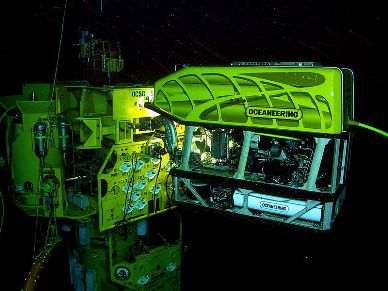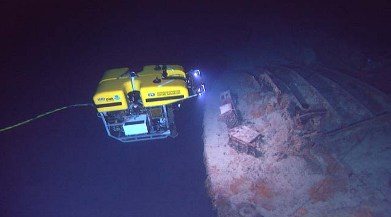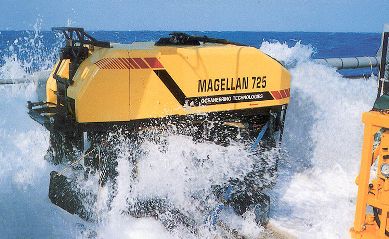
A remotely operated underwater vehicle also referred to as an ROV, is an underwater vehicle that is unmanned and usually tethered to the operator.
The unmanned vehicle is similar to a robot, which is fitted out with sensors and sampling tools to collect various types of data.
A network of cables is utilized to establish a connection between the operator and the remotely operated vehicle, which would enable the proper movement of the ROV.
ROVs are incredibly complex and serve a wide variety of purposes. From exploration and unmanned expeditions to research and sporting events, they can be found in a diverse set of fields.
In this article, we will look at some of the salient features about ROVs, their usage, categorisation, preparation, launching, operation, and shortcomings.
What is a Remotely Operated Vehicle?
An ROV is essentially a robot that can operate underwater. It operates much like a miniature submarine, but without the people operating it from onboard.
It works either wirelessly or through a wired connection, although the latter is more common. There are several subsystems that together make up the incredibly complex ROV.

The various components that form the broad operating mechanism of the ROV are-
1. Electrical systems (wiring and circuitry),
2. Mechanical structures,
3. Sensors and appendages, and
4. Task-specific structures.
The base frame on which all these systems are supported is the skeleton of the ROV. It is made as light as possible to prevent any additional weight and drag during motion.
It is covered with a structure known as the Manifold, to prevent accidental damage to the internal components. There are holder clips along its frame members to support wiring and other electrical circuit components.
The skeleton is built to withstand impacts termed as “severe” and makes use of the triangulation principle of rigid mechanics. To understand how triangulation works, consider a square frame.
Any force at a vertex would lead to buckling and collapse of the frame. Instead, a diagonal member is introduced, it provides additional strength in tension.
By just adding a single member, the strength is increased across the frame. In particularly weak areas, an X-joint is included, with 2 diagonal members for added strength in both tension and compression.
Subsystems and Materials Used in ROV Design
The electrical systems refer to the wiring and circuitry that make up the heart of the ROV. The only reason they are so useful and can be used in a variety of fields is due to the highly robust and complex nature of the electronics outfitted on them.
The primary components include the main motherboard and processing unit, where instructions are fed in from a controller, and then converted into a physical output.
The controller is manually operated in most cases, and autonomous underwater vehicles (or AUVs) are incredibly rare in this field owing to the various challenges presented.
Signals from the controller input are either wired or wireless based on the level of innovation and design. It may also be task-specific. For instance, to conduct research on an underwater wreck site, a wired robot may easily get entangled.
On the other hand, a wireless signal may be blocked as the robot heads deeper into the wreckage. So, a careful evaluation of the working conditions and possible hazards should also be done.
Once the signal reaches the onboard receiver, it is conveyed to the mechanical systems. The main system is propulsion, which is in the form of miniature and specialized marine propellers.
Powered by small servo motors that are housed in waterproof casings, the propellers number 2 with between 3 to 5 blades per shaft. They can be operated in both clockwise and counter-clockwise directions to create steering as well.
Some advanced ROVs used in wreckage analysis and deep-sea exploration also have swivel jointed propellers. These are rarely used and tend to be more costly than their fixed counterparts. It is only required in situations where very high precision is required.
Sensors and appendages form the very core of the ROVs functionality. The most common equipment that is fitted include cameras, depth gauges, temperature sensors, and internal system sensors.
Cameras are used by the operator since they must have eyes on their surroundings. Depth gauges are used to ensure that the ROV is at the required depth and does not descend into a high-pressure zone.
Temperature zones detect how the water temperature changes, and is useful in detecting subsea thermal vents and thermoclines. Lastly, internal system sensors ensure that the ROV is functioning perfectly and that all systems are working as required.
Task-specific modifications are what makes an ROV customizable and usable in a wide variety of fields. For instance, in historical exploration and wreckage visits, it can be used to collect artefacts with mechanical arms and tools.
For subsea geological exploration, it can be fitted with rock cutting tools to extract samples for analysis. For mapping the seabed, it is equipped with LiDAR, SONAR, or RADAR to ping and receive reflected waves off surface elevations and valleys.
Although a basic camera is usually there, they may be specialized cameras capable of thermal imagery, high precision photography, macroscopic lenses etc.
The choice of materials is very important to an ROV. The frame must be light enough where it does not affect the performance of the vehicle, while it should also be strong enough to withstand mild to severe impacts.
Electrical systems must be encased in insulated coatings and housed in waterproof containers. Special attention must be paid to anti-corrosion materials to prevent any usage issues.
As the ROV spends a great deal of time underwater, there is a lower chance of rusting (lack of oxygen, which is necessary for rusting).
However, when on the surface, the probability of corrosion increases (dampness combined with atmospheric oxygen). For this, thorough drying must be undertaken and the ROV must be stored in a dry and clean environment to prevent any sort of fungal growth or corrosion.
The problem of marine growth is prevented by adding special paints that break down existing microbes and prevent new ones from attaching to the ROV surface when underwater.
Usage of ROV
ROVs are used for various purposes and are outfitted accordingly. This is why the majority of unmanned vehicle manufacturers provide a basic skeleton or structure on which modification can be made. The basic structure is known as the “frame” or “template” of the ROV. In this section, we take a look at the various uses to which these devices are put.
An underwater ROV is well-equipped with modern technology and consists of a lighting system and a video camera, to record a better subaquatic panorama and contribute to geology education and learning about sea life.
With incessant developments in the arena of technology, the latest technical concepts are being imparted to remotely operated vehicle in order to amplify its original capacities to a greater extent. Extra machinery can comprise of a static camera, a water sampler or even a manipulator.
Moreover, a remotely operated underwater vehicle can also incorporate advanced instruments for appropriate measurement and evaluation of current temperature, penetration of light and the water clarity.
These are commonly used in scientific and exploratory ROVs to learn about the underwater environment. Chemical analyzers are used to also study the specific makeup or composition of water at various locations and depths.
ROVs or underwater robots were primarily invented to serve an industrial purpose, regarding regular pipeline inspection (both interior and exterior) and to conduct structural testing methods on certain platforms, from various offshore locations.
These ROVs are even useful for the exploration of oceanic water wreckage sites and historical ruins. The ROVs cater to the needs of innumerable science expeditions, and several educational programs at aquaria.
Categorization of ROVs
Underwater ROVs can be distinguished into various classes by evaluation of their weight, power, abilities and their sizes. The Micro ROV is small-sized and weighing below 3kg.
The primary classifications used are as follows:
1. Micro ROVs
2. Mini ROVs
3. General ROVs
4. Inspection Class
5. Light Work Class
6. Heavy Work Class
7. Trenching and Burial ROVs
These attributes enable the ROV to explore minuscule cavities or pipeline cracks, which is physically impossible for a diver to achieve.
The Micro ROV is small-sized and weighing below 3 kg. These attributes enable the ROVs to explore minuscule cavities or pipeline cracks, which is physically impossible for a diver to achieve
On the other hand, the typical Mini underwater ROVs have a standard weight of around 15kg and it takes just one person to easily operate it from a boat, and carry out an underwater expedition.
The micro and mini categories of remotely operated vehicles can be termed with an alternative “eyeball” as they do not participate in intervention undertakings.
The General ROV type is usually below 5 HP (propulsion) and comprises of three-finger manipulators, like in the old RCV 225. These are specially built to aid in light survey tasks as these usually bear a sonar unit.
The standard underwater depth is around 1000 meters, but one ROV has been upgraded to even traverse till 7000 meters.
The Light work class remotely operated vehicle is generally below 50 HP and can support several manipulators. These ROV’s allow a maximum working depth of 2000 meters. Polyethene, which is a kind of polymer, is used in construction which varies from the typical aluminium alloys or stainless steel.
The Heavy workplace machine supports below 220 HP with two manipulators and can achieve a depth of 3500 meters.
These ROVs can have a lifting payload of over 5,000 kilograms. They can also be modified to work with multiple manipulators. The most common application of the heavy work class is in deep-water installations and subsea tie-ins.
The Trenching ROV offers a 200-500 HP range and can be utilized till 6000 meters. While most propulsion systems on these ROVs function below 500 HP, there are underwater vehicles that may function at powers of nearly 600 HP or more.
They are commonly used in cable laying, the safe creation of seabed trenches, and the partial or complete anchoring (burial) of subsea components used in the oil and gas industry.
Lastly, there is another classification of submersible ROVs on the basis of how they are launched. There is a system known as Tether Management System (or TMS) that controls the payout for the umbilical cord that delivers power and control to the ROV. It is known as a free-swimming vehicle when it is directly connected to the ship or observation platform.
In such cases, it is neutrally buoyant. On the other hand, there are some ROVs that are stored within compartments called garages that are lowered into the ocean.
During the launching, the ROV ejects from the submerged compartment and has its tether connected to the garage, NOT the ship. Choice of the launching system depends on usage, depth, function, and geographical factors.
Preparation and Launching of ROVs
The size range of a remotely operated vehicle is very impressive, as it may vary from a small bread box to a minor truck. The preparation of the launch of an underwater vehicle can be very simple to operate as the robot can be merely dropped into the water from the vessel.
The recovery procedure may involve big windlasses to uplift the robot from the water. Generally, A-frames are available to swing over the ROV safely onto the deck.
Sometimes, extra structures called “garages” are present which are lowered to the rear end. These “garages” can act like a temporary yet secure den, and the ROVs can return once the expedition gets over.
The occasional excursions carried out by employing the remotely operated vehicles are considered to be much safer compared to the usual diving expeditions which can lead to physical injury or even death.
A remotely operated underwater machine can prove to be highly efficient when it comes to dealing with a submersible, as the cutter blades or the manipulator’s arm can come in handy while rescuing the submersible if it is stuck and unable to move freely.
Another drawback of submersible ventures is that bad weather conditions can prove to be a major hindrance, whereas a remotely operated vehicle can remain unaffected. As an added utilization, research can initially submerge the ROV into the water to explore the detailing of the particular underwater site and then decide if it is safe enough to send a submersible.
In general, prior to ejecting the ROV from the side of the ship or launching platform, the ROV is gently lowered into the water. The reason it is not allowed to splash is because of the risk of damage to the sensitive equipment on board. Windlasses may be used here, or if the freeboard isn’t too high, it may be manually lowered by hand.
In the case of choppy waters that increase the risk of damage during splash zone entry, a moon pool may be used. Moon pools are enclosures within a vessel that is hollow and has the water surface at its lower end.
A column of water is created in which the water is relatively steady. To prevent resonance related damage, dampers are also used to reduce the heaving motion. ROVs can be lowered through the moon pool in case of poor weather conditions.
Famous ROVs
Amongst well-known underwater ROVs, the Ventana runs on hydraulic power and can traverse to a depth of 1850 meters. The Ventana is manipulated from the RN Point Lobos ship deck.
On the other hand, the MBARI franchise has purchased the ROV Doc Ricketts way back in 2008, which offers an incredible capacity of going deep down till a depth of 4000 meters.
This remotely operated vehicle has undergone constant up-gradation, ever since. The Doc Ricketts served as a magnificent replacement to the earlier ROV Tiburon, which could also travel down 2.5 miles.
These special submarines have enabled easy exploration of several deep-sea gas and oil reserves, than before. Many oil reserves were are hard to locate by using the divers and hence caused a major commercial setback.
Interestingly, the undetermined locations of famous shipwrecks like the RMS Titanic, USS Yorktown, SS Central America, and the German warship Bismarck have been discovered due to some help from the ROV industry.
In the case of SS Central America, the remotely operated underwater vehicle has also been able to retrace and gather important materials from the seafloor of the shipwreck.
Shortcomings
A high-power signal that can be used to control ROVs across a large distance is the preferred design. It will have a longer range than what is currently possible with tethered designs. However, high power and frequency may affect marine life.
The other alternative is a low power main signal that is coupled with several amplifiers at regular intervals to create a larger range for the ROV.
Although it will be more expensive, it is preferred from an ecological viewpoint. Unfortunately, the issue with the low power option is that it would cause cluttering of the sea surface due to a larger number of amplifiers required to function.
A huge setback of a remotely operated underwater vehicle is that it lacks human presence which makes it difficult for executing the visual surveying down in the underwater. The vehicle remains attached to the main boat above water through intricate wiring and this leads to a restriction of free movement.
Research and innovation are currently being undertaken in the field of wireless control for ROVs. The proposed design suggests 2 main models for implementing this control.
A high-power signal that can be used to control ROVs across a large distance is the preferred design. It will have a longer range than what is currently possible with tethered designs. However, high power and frequency may affect marine life.
The other alternative is a low power main signal that is coupled with several amplifiers at regular intervals to create a larger range for the ROV. Although it will be more expensive, it is preferred from an ecological viewpoint.
Unfortunately, the issue with the low power option is that it would cause cluttering of the sea surface due to a larger number of amplifiers required to function.
Disclaimer: The authors’ views expressed in this article do not necessarily reflect the views of Marine Insight. Data and charts, if used, in the article have been sourced from available information and have not been authenticated by any statutory authority. The author and Marine Insight do not claim it to be accurate nor accept any responsibility for the same. The views constitute only the opinions and do not constitute any guidelines or recommendation on any course of action to be followed by the reader.
The article or images cannot be reproduced, copied, shared or used in any form without the permission of the author and Marine Insight.
What is Remotely Operated Underwater Vehicle (ROV)? appeared first on Marine Insight - The Maritime Industry Guide


